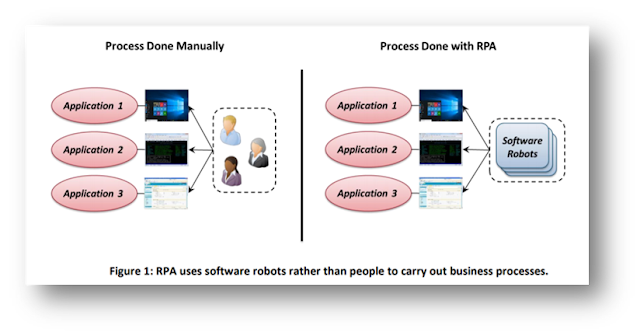This article would provide a basic overview of RPA, including its definition, benefits, and limitations. It would be easy to read and understand, without getting too technical
What is Robotic Process Automation?
RPA is a software application that can replicate processes humans would do to move information through and between different technology systems.
Robotic Process Automation is the technology that allows the automation of the task in exactly the way how a human does.
Typical types of business
processes in which RPA can be used
- Repetitive tasks carried out 50-60 times a
day.
- Periodic reporting, data entry and data analysis
- Conversion of data format and graphics
- Process list and file storage.
- Mass email generation, archiving and
extracting.
- ERP and other back office transactions.
How RPA Works?
RPA can execute necessary tasks, which are generally repetitive and rule-based, much better than humans. RPA bots transform back office by interacting with the user interface of a computer system just like humans.
- Blue Prism : https://www.blueprism.com
- Automation Anywhere : https://www.automationanywhere.com
- UiPath : it is a RPA software. It helps organizations to automate processes efficiently. It can be download from http://www.uipath.com
The word “robotic” does not refer to a physical robot – instead it is about a software based robot ( or bot) that can automate human actions in the workplace.
RPA involves bots that perform a set of specified actions or tasks.
Limits:
RPA technology is somewhat constrained. For the most part, it works primarily for tasks that are routine and repetitive. If there is a need for judgment – say to approve a payment or to verify a document – then there should be human intervention.
- RPA is software that helps to automate certain business tasks. One way to think of this is as a digital worker.
- RPA is not a macro. Some of the reasons include the following: RPA can handle many applications and technology environments and there are ways to easily create the automations (such as by recording actions of a worker). There are also other potential features like AI.
- Attended RPA and Unattended RPA.
What are the areas that are right for RPA?
- Tedious work : It’s the kind of activity that require little knowledge. This could be cut-and-paste and clicking a variety of buttons.
- Time-consuming: Which types of processes result in late outcomes? For creating report or doing end-of-quarter processing.
- Repetitive : The process has a set of steps that rarely change.
- Frequency: To get real value, the process is something that is recurring. This may be where a person engages in the activity a few times a week.
- Rule-Based: This is because RPA allows you to easily create workflows, which have features like IF/Then logic to carryout actions on a consistent basic.
- Clearly Defined Processes
- High volume
- Prone to error : Are there areas where data input errors are common?
- API : if an API is not available then the process could be a good candidate for RPA automation.
- Customization
- Sensitive Data : A well-defined RPA bot you should have much better protection of the data.
- Scale
- Organization
- There is a free version of the software.
- There are a large number of integrations such as with Google and Microsoft.
- It comes with hundreds of prebuilt actions which helps to streamline the bot development process.
The there is the community edition which is free.




